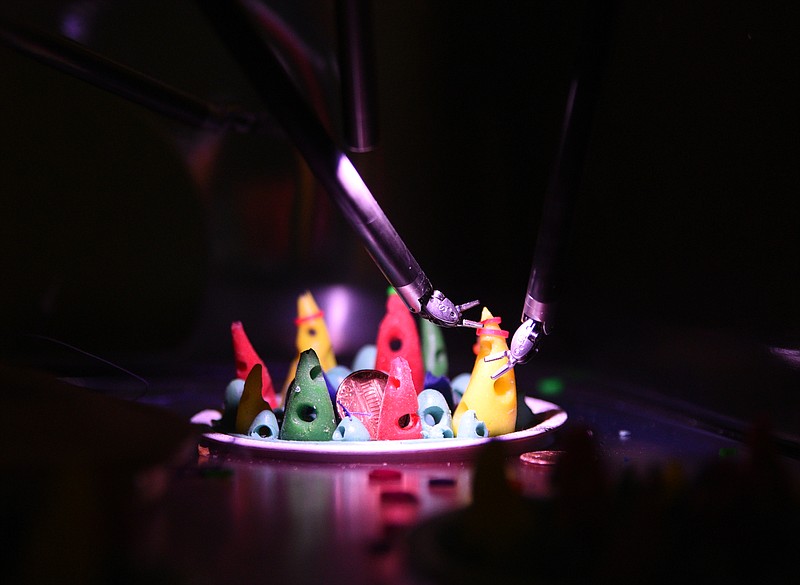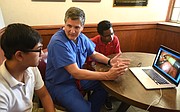Sims Pettway was smitten.
"It was really immersive, incredibly smooth and precise," the 17-year-old Baylor School senior said.
Pettway, of Lookout Mountain, had just spent five minutes Thursday morning manipulating a robotic arm set up in the school's Weeks Science Building, mimicking the actions of a surgeon who might use the expensive, cutting-edge device to perform heart or prostate surgery.
Did the experience convince him to pursue a surgical career?
No.
"Surgery is impressive, but what interested me the most was the mechanics behind it," he said.
That response brought a smile to the face of Dawn Richards, chairwoman of the science department at Baylor, who was watching the students try out the gear.
"This is getting them so excited about science," she said.
Guiding the students was Dr. Rob Headrick, a 1982 Baylor graduate who now uses the robotic gear himself as a surgeon at CHI Memorial's Chattanooga Heart Institute and Buz Standefer Lung Center.
Back in February, Headrick accepted an invitation from the students' science journal club to do a presentation, and he mentioned that the company that manufactures the da Vinci robotic surgery gear would be willing to set up a demo if they were interested in getting their hands on the equipment.
They were.
"All the slots [to use the gear] filled immediately," Richards said, even though the students were doing this on their own time and not as part of a class project.
"I wanted to put some of this highest technology gear in the hands of the kids," Headrick said, "and stimulate students to start thinking about problems. Somebody had to write the software, somebody had to do the optics, the camera, work with surgeons and train them. There are so many aspects this brings in."
The robotic surgery gear incorporates robotics, biology, computers and elements of virtual reality, all topics students address in their science classes at Baylor.
The operator, whether student or surgeon, sits with his or her head partially inside a half-domed module, where a 3-D screen displays the inside of a patient's body or, at Baylor, a brightly colored set of knobs and rubber bands and a shiny penny. The camera and the robotic tools, which can include clippers or needles or clamps, are in another module that can be 20 to 30 feet away across an operating room.
On Thursday, each student took turns picking up rubber bands and placing them on the colored knobs, and turning over the penny.
"You place your hands with the middle finger and thumbs in the grip," Pettway said. "You can move it 360 degrees, in and out, it is completely intuitive."
Pettway is no stranger to technology. Last year at Baylor, he built a quadcopter drone, with a 3-D printed graphics frame. He's headed for Georgia Tech this fall, where he plans to major in mechanical engineering, then get a master's degree in business administration and eventually, "my dream job would be to have my own startup tech company."
That is just what Dr. Headrick wants to hear. When he first was asked to speak to the science journal club, he was wary.
"We're often critical because the next generation of kids are different, they have grown up very differently, but I was blown away by their inquisitive nature," he said.
Headrick remembered his own experience at Baylor, where he says he almost flunked out initially. "It challenged me, but it put me in a position to have opportunities," he said.
Now he is sharing those opportunities.
"Chattanooga has given a lot to me. So how do you give that back? I want to try to start reaching back out to the community, and maybe one of these kids will be the next Bill Gates or Steve Jobs."
Contact staff writer Steve Johnson at 423-757-6673, sjohnson@timesfreepress.com, on Twitter @stevejohnsonTFP, and on Facebook, www.facebook.com/noogahealth.

